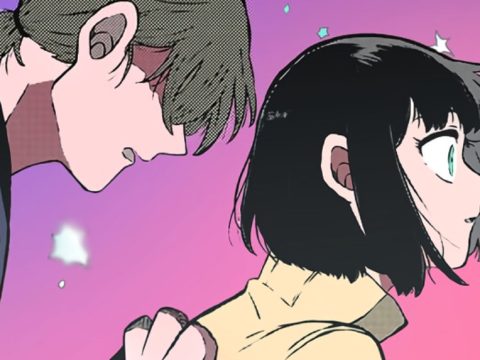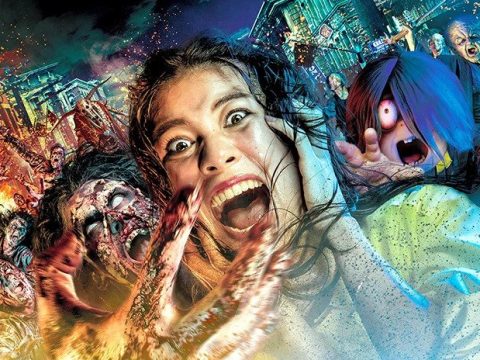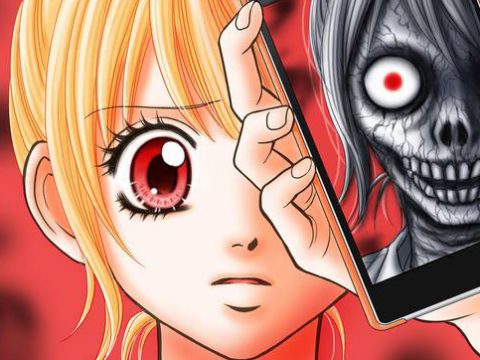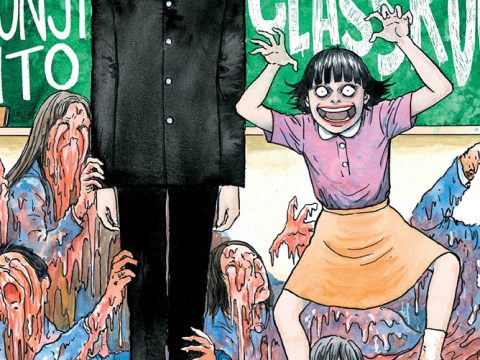
Halloween comes but once a year, and what better way to celebrate the bewitching season than with an anime about things that go bump in the night? Unfortunately, very few horror-themed anime receive commercial releases in English-speaking countries, and most of them have more in common with J-horror movies than with the sort of cultural traditions that encourage Americans to dress up in costumes, play pranks, and distribute candy to strangers. So I submit for your approval this artifact from the Vault, a vampire anime that a) doesn’t suck and b) takes place during Halloween. The anime is Blood: The Last Vampire, a short film that is over a decade old now, yet it remains as fresh as ever with visuals as sharp as the edge of a katana.
The story is simple: Saya, a mysterious young lady with a sour disposition and a samurai sword, hunts Chiropterans (bat-like, shape-shifting vampires) at the behest of an unspecified branch of the American government. In the autumn of 1966, Saya poses as a transfer student and infiltrates Yokota Air Base in Fussa, Japan. Her mission is to track down a pair of bloodsuckers that have been preying on the local populace and disguising their feeding sessions as a string of tragic suicides. Will Saya manage to slay her targets? Or will the monsters escape under the cover of the base-wide Halloween party and live to stalk another day?
Despite its straightforward plot with a heavy emphasis on action and atmosphere, Blood: The Last Vampire can be quietly subversive sometimes. Its opening scene, in which Saya slaughters a suspected Chiropteran in an isolated train car, is a reversal of Little Red Riding Hood. It inverts the imagery of damsels in distress. Here the monster must fear the maiden, not the other way around. Similarly, the film subtly pokes fun at the anime fetish for the sailor fuku, the high school uniforms worn by young Japanese women. Saya wears such a uniform in order to blend in as she hunts her targets, but because she’s undercover on a U.S. military base with no such dress code, she ends up sticking out like a sore thumb. Finally, as Brian Ruh astutely observes in his book Stray Dog of Anime, there’s a grim irony present in the film’s conclusion, in which bombers depart Yokota Air Base to fly missions over North Vietnam. The bombers clearly have a much greater potential to kill people than a few lowly vampires, yet their presence is never questioned and never challenged.

Blood: The Last Vampire was a success in Japan, and it spawned a series of light novels, a manga adaptation, two television series, a couple of video games, and a live-action film that shares the same name. Sadly, the element of mystery that makes Blood compelling didn’t translate to Blood+ nor to Blood-C, the animated television shows that were created to expand and reinterpret the story of Saya. The live-action movie is spectacularly bad, with disastrous special effects and a plot that attempts to explain entirely too much. In the animated film, the audience learns little about Saya’s background and even less about her motivations. From a dearth of information they must draw their own conclusions based on Saya’s actions (which are violent) and her words (which are few and far between). Is her aversion to religious symbols a physical weakness, or merely something psychological? What’s the significance of Saya offering her own blood to a mortally wounded Chiropteran near the film’s conclusion? And why does she have an almost beatific expression on her face when she does so? These and other questions go unanswered, but Blood: The Last Vampire feels stronger for cultivating a sense of ambiguity.
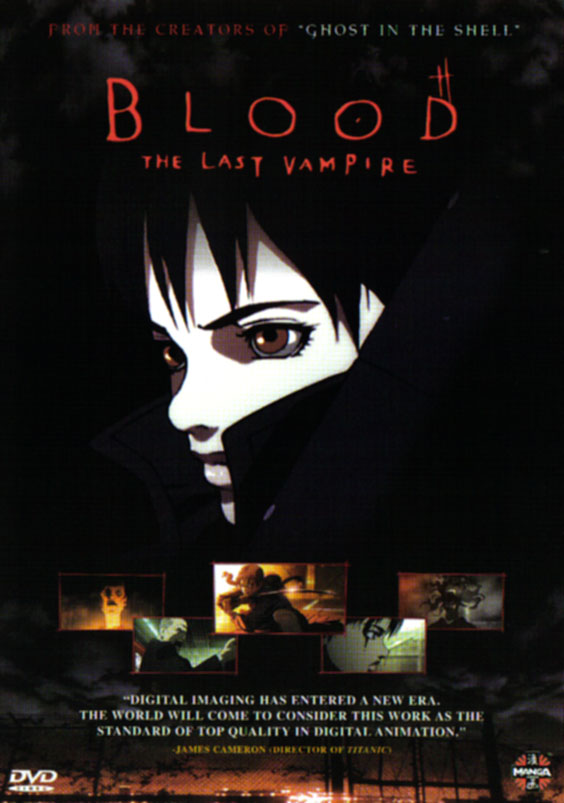 The film is a collaboration of numerous artists. Kenji Kamiyama, director of Ghost in the Shell: Stand Alone Complex and Eden of the East, wrote the script. Hiroyuki Kitakubo (Roujin Z, Black Magic M-66) directed the film, a task that required blending traditional 2D animation with 3D CG elements in a manner that was novel at the time. Mamoru Oshii oversaw the production, and Production I.G provided the animation. The unusual character designs by Katsuya Terada also deserve special mention. In Blood, people come in a variety of shapes and sizes, including some that are ugly or unattractive. For example, unlike the average beautiful teenage heroine, Saya scowls constantly. In the moments where she isn’t looking grumpy, her face is contorted into a mask of adrenalin-pumping rage. I especially love the design of the school nurse; she’s atypically plump and has a distinct talent for pulling hilariously shocked faces when confronted with imminent mortal danger. Viewers may find some of the depictions of African-Americans troublesome, perhaps even stereotypical. I can offer no excuses there.
The film is a collaboration of numerous artists. Kenji Kamiyama, director of Ghost in the Shell: Stand Alone Complex and Eden of the East, wrote the script. Hiroyuki Kitakubo (Roujin Z, Black Magic M-66) directed the film, a task that required blending traditional 2D animation with 3D CG elements in a manner that was novel at the time. Mamoru Oshii oversaw the production, and Production I.G provided the animation. The unusual character designs by Katsuya Terada also deserve special mention. In Blood, people come in a variety of shapes and sizes, including some that are ugly or unattractive. For example, unlike the average beautiful teenage heroine, Saya scowls constantly. In the moments where she isn’t looking grumpy, her face is contorted into a mask of adrenalin-pumping rage. I especially love the design of the school nurse; she’s atypically plump and has a distinct talent for pulling hilariously shocked faces when confronted with imminent mortal danger. Viewers may find some of the depictions of African-Americans troublesome, perhaps even stereotypical. I can offer no excuses there.
Nonetheless, all of the creative talent poured into this project makes Blood a unique viewing experience, albeit one with a running length just shy of fifty minutes. It’s the perfect kind of entertainment to accompany a late night binge on fun-sized Snickers bars. If you desire something spooky this Halloween, why not try a little taste of Blood?
Distributor: Manga Entertainment
Originally released: 2000
Running Time: 48 minutes


